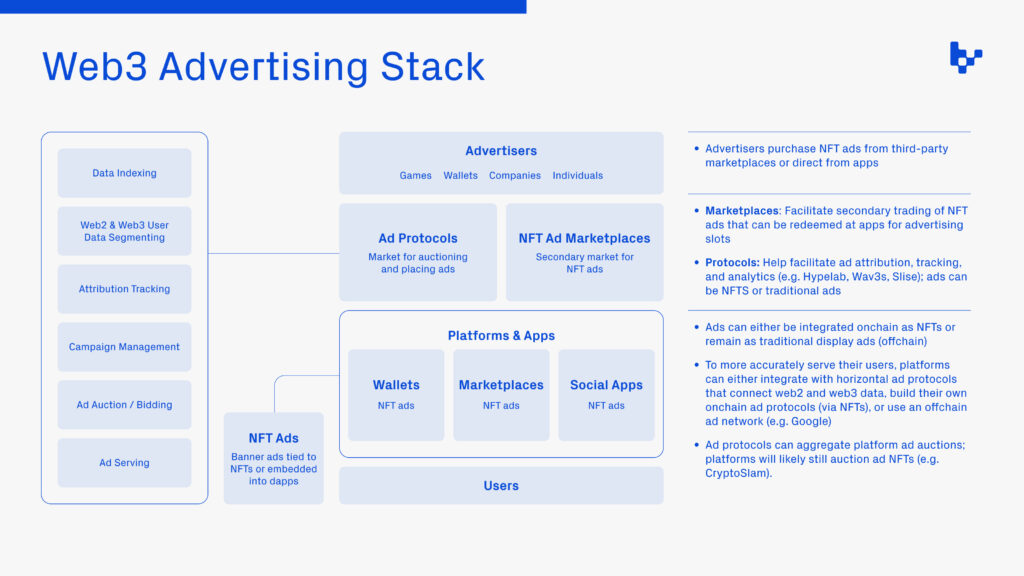Mason Nystrom
‘This Protocol Is Brought to You By’: An Onchain Model for Web3 Advertising
Three potential directions for web3 advertising
Crypto has always been reluctant to use advertising as a business model.
Ads in general can stir up negative associations for many internet consumers. Web2 tech giants milk user data and serve it back to us in the form of super-targeted ads. Moreover, most smaller-scale individual creators haven’t been able to convert ads into a stable income, relying instead on subscriptions to make money online.
But advertising aligns the objective of broad product distribution with a viable revenue stream, making it one of the best monetization models out there. This is why social and search networks subsidize their platforms with ads, and top content creators leverage ads over subscriptions on platforms like Substack and Spotify.
The open nature of crypto protocols breaks down traditional platform business models that rely on siloed data and user lock-in. Core elements of the web3 advertising stack are already emerging, including advertisers, ad protocols, marketplaces, and applications. As crypto platforms search for viable business models, the advertising model sits there, waiting patiently for its inevitable adoption.
But web3 ads don’t have to mirror their web2 counterparts. While all of the web3 advertising stack components are important to the future of crypto-native advertising, let’s focus on the atomic unit of the advertising stack, the ads themselves.
Emerging web3 advertising models
Three models in particular are emerging to define the web3 advertising space:
- Onchain ads: NFTs ads, NFT referral links, and NFTs as claims on ad space
- Token-curated ads: tokens that govern attention assets on a platform (i.e. homepage content, storefronts, and NFT drops)
- Hybrid ads: Traditional offchain ads that leverage onchain protocols or attribution engines to connect offchain and onchain data
Onchain Ads: NFT ads & affiliate programs
One of the first examples of onchain advertising comes from NFT data aggregator CryptoSlam, which experimented with NFTs that grant the owner rights to the banner ad slot on its homepage. For a few weeks in January, each NFT ad corresponded to a specific day’s banner ad and was only redeemable through CryptoSlam, allowing the NFT aggregator to enforce some content moderation.
By further financializing ads into NFTs, CryptoSlam can create a secondary market for its ads and turn them into a valuable asset class that provides ongoing royalty revenue. Importantly, enforcing royalties for ad NFTs can be quite simple, as platforms or ad protocols could mandate that buyers pay royalties to receive the ad utility.
Beyond NFT ads, crypto enables more effective and dynamic affiliate programs. Affiliates can leverage tools like ShareMint or Fuul to provide onchain referral links that dynamically reward referrers, employ token-gating for targeted rewards programs, and combine offchain data with onchain actions and conversions. Sound.xyz, a music NFT minting and marketplace protocol, utilizes “curator rewards”; fans earn 5% on primary mints generated through their referral links and playlists. As more formerly-offchain actions become onchain experiences, it will be possible to economically incentivize and reward affiliates and curators for creating value in the product-marketing life cycle.
Token-curated ads
On social networks, companies pay to gain extra attention. In web2, paying for advertising on Google lets a website appear above other sites in search results, which is crucial since the second page of Google basically doesn’t exist. Crypto platforms can leverage tokens as an instrument of attention curation, too.
SuperRare, the NFT art platform, utilizes its RARE token for curation in a few respects. First, SuperRare leverages token holders’ curation rights, i.e. voting powers, for its Space Race, which determines which entities or individuals get to create SuperRare Space storefronts. Galleries are valuable digital real estate in SuperRare and effectively function as advertising because the top Spaces can garner more views and more sales volume.
Curation can go a step further. Imagine if you could stake tokens to govern which storefronts appeared first on the front page of your site/marketplace/social app. In this model, curation tokens would act as a liquid form of advertising, but with the added benefit that part of the revenue from the storefronts and sales on the SuperRare protocol accrue to token-holders. Curation can allow tokens to capture additional value and provide utility to platform stakeholders. Importantly, it can also be a way for a marketplace app (e.g. SuperRare.com) to continue to drive value to the underlying protocol token ($RARE).
Hybrid generalized ad protocols
Several companies, such as Spindl, Wav3s, MadFi, Slise and Hypelab, are building protocols focused on user activity attribution. That is, they connect a user’s offchain and onchain identities. For example, say an NFT marketplace wants to know the effectiveness of its marketing campaigns; by using an attribution protocol, the marketplace can track whether an individual who clicks a referral link or a Twitter ad, 1) actually goes to their protocol and 2) converts by buying an asset on the marketplace.
Advertising will naturally adapt with new protocols. For example, the advertising protocol Wav3s integrates with Lens, tapping directly into the open social graph to enable creator advertising. Wav3s lets creators pay people who promote their content (e.g. mirroring it, retweeting it, etc.). More importantly, it splits a portion of the revenue with Lens apps like Phaver, Orb, and Lenster proportional to the number of promotions each app generates. Similarly, platforms like Layer3 offer new forms of customer acquisition; companies can advertise and reward users on the platform if they complete certain onchain actions.
Where do web3 ads go from here?
Very few web3 companies or protocols have implemented advertising as a business model, which leaves a lot of open questions about what comes next:
- Will ads stay offchain, or will they make their way onchain as NFTs?
- Will platforms that control distribution (e.g. marketplaces, aggregators, social media platforms) remain in control of their attribution engines, or will the open and permissionless nature of web3 data allow third-party attribution protocols to provide more robust activity tracking and user profiling?
- What unique models for attention capture will web3 enable?
My hypothesis is that while the vision of generalized protocols that serve ads across platforms is incredibly exciting, it’s also the least likely model to dominate in the long run without distribution.
Even in a world of open data, apps or marketplaces that control user distribution and attention will most likely try to control their ad experience. That may be because they want to moderate content, increase their take rate, or use offchain data to target customers in their apps more effectively. Attribution protocols will still have their place in crypto, but my sense is they will likely get acquired by leading crypto social platforms, similar to how AdSense was purchased by Google.
The difference this time is that it’s clear how valuable attribution engines will be. AdSense sold for $102 million, and the outcomes for these protocols will be 10x more significant.
Following this hypothesis, I’m most excited about platforms that issue onchain ads—that is, ads as an asset class—and apps that are leveraging new advertising models. If you’re building consumer apps, protocols, or something entirely new in web3 advertising, I want to hear from you: [email protected].
+++
Disclaimer: This post is for general information purposes only. It does not constitute investment advice or a recommendation or solicitation to buy or sell any investment and should not be used in the evaluation of the merits of making any investment decision. It should not be relied upon for accounting, legal or tax advice or investment recommendations. You should consult your own advisers as to legal, business, tax, and other related matters concerning any investment. Certain information contained in here has been obtained from third-party sources, including from portfolio companies of funds managed by Variant. While taken from sources believed to be reliable, Variant has not independently verified such information. Variant makes no representations about the enduring accuracy of the information or its appropriateness for a given situation. This post reflects the current opinions of the authors and is not made on behalf of Variant or its Clients and does not necessarily reflect the opinions of Variant, its General Partners, its affiliates, advisors or individuals associated with Variant. The opinions reflected herein are subject to change without being updated.

